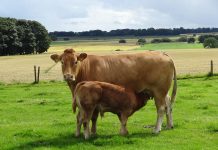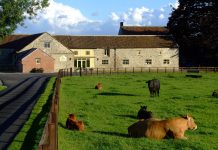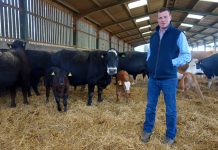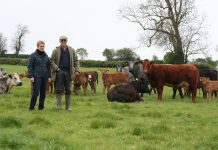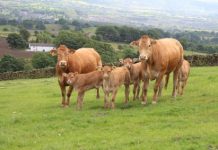Feature on Will and Gillian Sedgley, Low Bank House, Barbon, Nr Carnforth, Lancashire
Making a start in farming certainly isn’t easy but a young couple on the border of Cumbria and Lancashire are proving that with hard work and determination there are still opportunities for new starters – and on their farm near Kirkby Lonsdale it’s the Limousin that’s making things happen.
“Without the Limousin we couldn’t breed cattle with the style and quality we need – and yet still rely on easy calving,” say Will and Gillian Sedgley who are fast earning a reputation for their “show potential” suckled calves.
“We must have the influence of the Limousin – it’s a key element of the type of cattle we’re producing and it’s where we want the business to go in the future. Commercial buyers rate the Limousin and a lot of our heifers are now being bought as herd replacements.
“There isn’t much more cost in producing a really top quality animal if the breeding is right in the first place – and for us that’s where the Limousin scores,” adds Will.
The Sedgleys married in 2006 and used their “wedding gift fund” to buy good quality beef-bred heifers to run on rented land where they established their herd. But two years ago they secured the tenancy of Low Bank House, Barbon, near Kirkby Lonsdale – a 110-acre unit run in conjunction with 650 acres of rented land on short-term lets.
Many of their suckled calves sold for primestock showing have already made their mark, including a class winner at the English Winter Fair.
“We began buying good quality store heifers from Christmas primestock shows and always bought the best females we could afford because we knew the type of calves we ultimately wanted to produce. And looking back some of them seemed very good value!
“I remember we bought the Christmas store champion heifer at Hawes for £600 even though it seemed a lot at the time,” recalls Gillian.
Over the next two years the aim is to build the herd up to 80 cows and then to 100 cows within five years – and to stay with the Limousin and British Blue combination of breeding.
 They now run 60 suckler cows comprising 20 pure Limousin – 10 of which are pedigree – 20 three-quarter-bred British Blues and half-bred Limousin x British Blue. There is also a flock of 650 Swaledale ewes producing North of England Mules, 600 Mule and Texel-crosses producing prime lambs and a newly established flock of 100 Swaledales to be bred pure.
They now run 60 suckler cows comprising 20 pure Limousin – 10 of which are pedigree – 20 three-quarter-bred British Blues and half-bred Limousin x British Blue. There is also a flock of 650 Swaledale ewes producing North of England Mules, 600 Mule and Texel-crosses producing prime lambs and a newly established flock of 100 Swaledales to be bred pure.
Netherhall Elect, a son of Fieldson Alfy and out of a dam sired by Wilodge Tonka, was the first Limousin bull bought by the Sedgleys. He shares sire duties now with Netherhall Henry who is a Malibu son out of an Alfy cow.
“We could have used AI in the early days but the way the pastures were laid out and with no handling facilities we had to use natural service. We started by using the Limousin on British Blue-sired cows and then put some pure Limousin cows to the British Blue.
“The aim was to give us cross-bred females carrying the genetics to breed us the type of calves we wanted,” said Will.
The half-bred Limousin x British Blue cows go back to the Limousin for their first two calvings to produce three-quarter Limousin calves. Cows are then put back to the British Blue to end up with a combination of the two breeds in varying concentrations.
Until this year the herd had calved from March to June but to ease pressure on buildings and on lambing-time labour needs, some cows have been switched to autumn calving. Most calves are sold at the springtime suckled calf sales at Kirkby Stephen Auction Mart at around 10-months-old, although some are sold straight off their dams in the autumn.
 The Sedgleys also like to have a couple of calves to sell at the Spring Spectacular sale of potential show calves held at Leyburn Auction Mart in North Yorkshire in March.
The Sedgleys also like to have a couple of calves to sell at the Spring Spectacular sale of potential show calves held at Leyburn Auction Mart in North Yorkshire in March.
Cows calve down in straw-bedded boxes where they stay for about two weeks before moving back into the cubicle house. Calves have access to a separate creep area where a creep mix is available from birth with continued access to dry feed throughout the time they are suckling to avoid a weaning check. Cows stay inside with their calves in the cubicle building until May.
Cow condition is carefully monitored and is considered an essential part of the herd’s management. In winter cows are fed clamp silage and straw – the mix depending on the silage analysis.
“We ration the silage because keeping the correct body condition on these cows is absolutely critical. We’ve got to get them calved easily no matter what the sire of the calf is, so we want them on a nice, steady plane of nutrition with no extreme changes so that we can calve cows at condition score 2.5-3.
“If they are too thin they don’t have enough milk and if they are too fat they aren’t easy to calve. But there’s always the risk of the fatter cows getting fatter and the thinner cows getting thinner during housing,” says Will.
So important is winter feeding that changes are being made that will hopefully ensure cow condition is achieved more efficiently.
“We’re going to switch to a mixer wagon this coming winter to improve the way the silage diet is delivered to the cows. It should prevent them sorting through the feed. The aim is to provide the cows with access to a correctly mixed silage and straw diet that will be available ad-lib.
“The current system favours the big cows which dominate the trough space and sort through the mix.”
The herd is now closed and is in the Premium Cattle Health Scheme with a risk level 1 for Johnes and accredited free of BVD. All cows receive a mineral bolus twice a year and are vaccinated for BVD and leptospirosis.
Heifers are calved at 24-months and are AI’d to easy-calving Limousin bulls. Bulls currently being used are Carmorn Dauphin and Oxygene.
“We were really pleased this spring because we retained our best heifers as replacements and yet were still £30 a head up on our average compared with the previous year,” says Will.
The herd’s average price achieved for all its 10-month-old calves this spring was £1059.
The first pedigree Limousin female to be purchased was the heifer Millington Grange Danielle bought privately. “We felt we needed to establish a nucleus of pedigree Limousin run under the Langstroth prefix, mainly because we didn’t want to rely on buying-in females and risk our herd health status.
“Danielle interested us because of her bloodlines – she was by the noted sire Objat and out of Voyelle. She was purchased in-calf to Oxygene and was then flushed before being AI’d again to Oxygene. We like the style of Oxygene’s progeny and he’s good to use on heifers,” says Gillian.
Running alongside their home-bred pedigree Limousin females are Ironstone Freckles, Hollythwaite Gloria and Gallaber Fancypants.
 AI sires used include the 40,000gns Mereside Godolphin as well as Powerhouse Elite and Wilodge Goldcard and the 32,000gns Rossignol son Huntershall Gladiator. Seven sires have been used this year.
AI sires used include the 40,000gns Mereside Godolphin as well as Powerhouse Elite and Wilodge Goldcard and the 32,000gns Rossignol son Huntershall Gladiator. Seven sires have been used this year.
Calves are weaned from November to January depending on which sale they are being aimed at. After weaning they are fed on ad-lib silage and 2-3kg of dry feed a day. Around six to eight of the best calves are halter-trained and put on to a ration with a higher oat inclusion rather than barley.
The Sedgleys have bred several prize winners at the Leyburn Spectacular sale of potential show calves but the best so far has been a heifer bought by John and Clare Cropper after standing champion at the May Kirkby Stephen sale. The heifer went on to win several local shows and its class at the English Winter Fair.
“We’ve now got regular buyers taking our cattle from the Kirkby Stephen sales and one has commented that he’s never had cattle achieve such high killing out percentages. Although our aim is to breed calves with show potential, the standards we set ourselves to achieve those calves have a knock-on effect in terms of the quality of all the calves we produce.”
ends
Text 2
The 110 acres at Low Bank House provides wintering for cows alongside grazing on Barbon Fell which is home to a new flock of around 100 Swaledale ewes that will be bred pure.
A block of 650 acres of rented land carries the main sheep flock of 650 Swaledales is put to Blue-faced Leicester tups to produce North of England Mules. There are also 600 Mule and Texel-cross ewes put to Beltex x Texel tups to produce prime lambs. The farm also carries 150-200 hoggs – Swaledale and Texel-crosses.
All Mule gimmer lambs are sold and replacements for Mule flock are bought-in as shearlings. There is also a flock of 25 pure-bred Blue-faced Leicesters that last year produced the Sedgley’s best breed price so far when a tup made £7000 at the main breed sale at Hawes.
“We buy-in draft Swaledales for the crossing flock but we are aiming to breed our own from the new flock we’ve set-up on Barbon Fell,” says Will.








